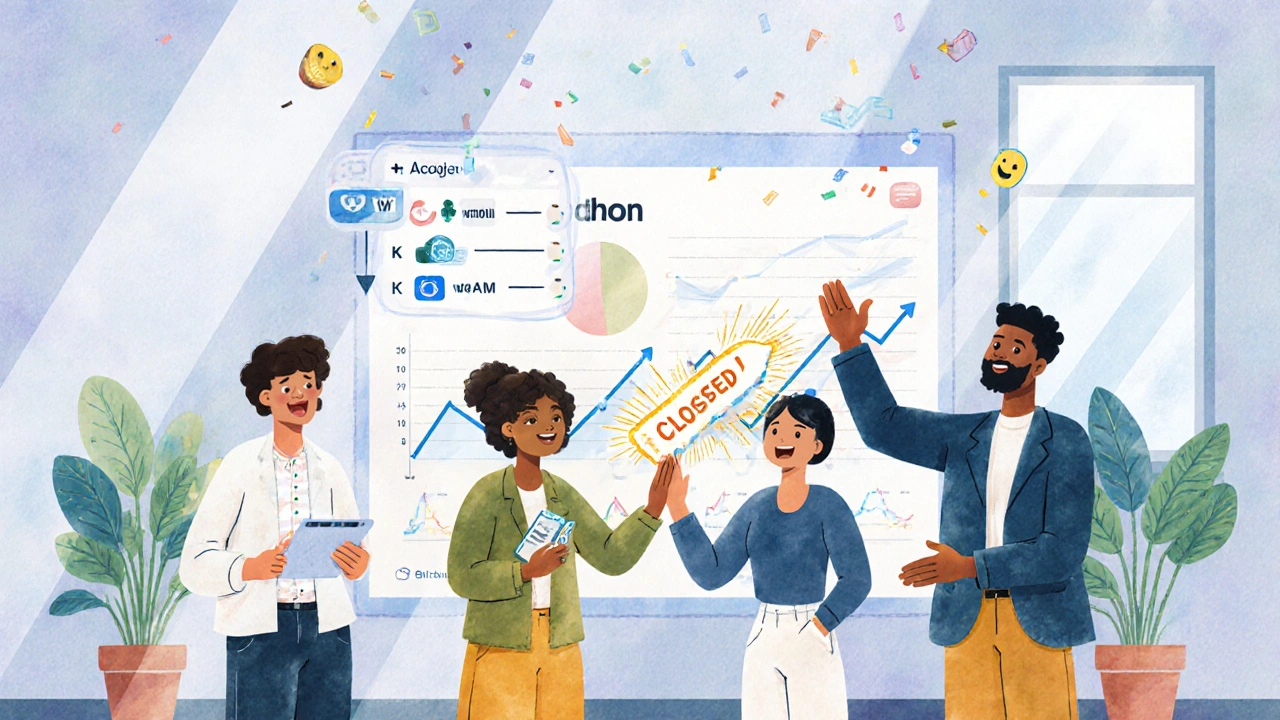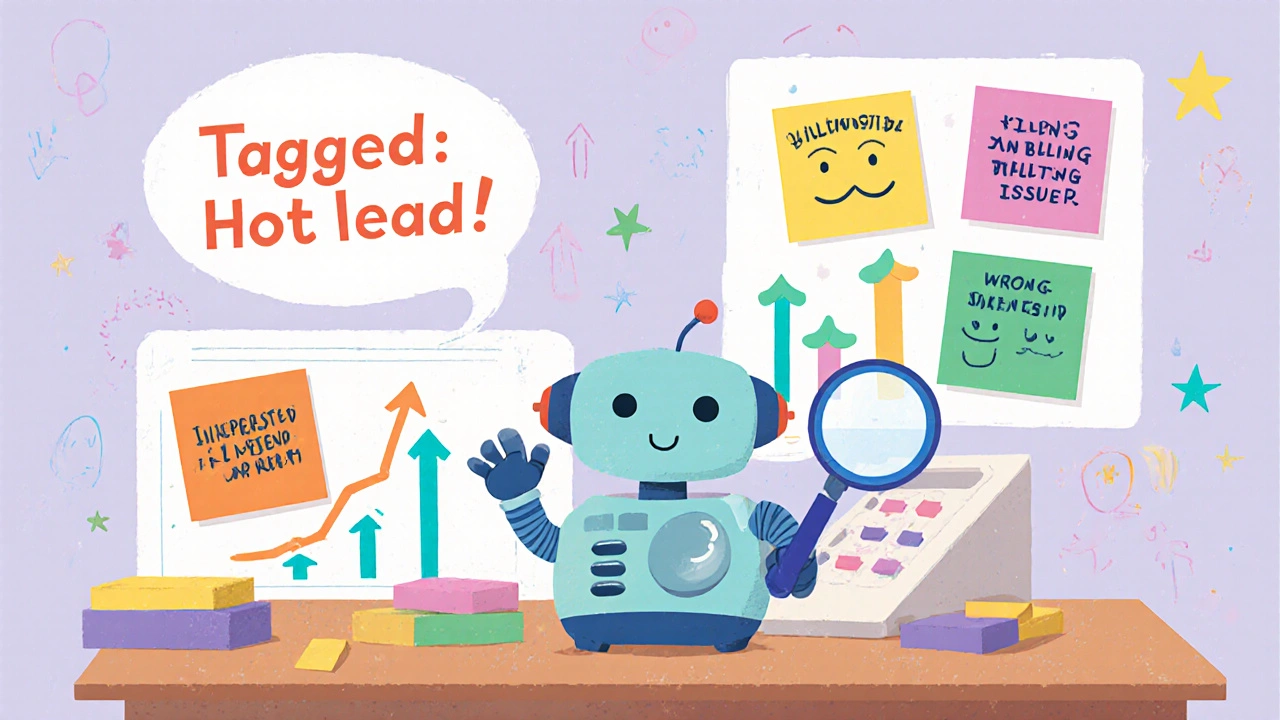Every phone call your team makes leaves behind a trail of information. But if you’re not labeling those calls, that data is just noise. In today’s VoIP systems, call tagging isn’t a luxury-it’s the difference between guessing what’s working and knowing for sure. Whether you’re in sales, support, or operations, tagging calls lets you turn hours of voice conversations into clear, actionable insights. No more asking agents, "What did they say?" or wondering why some leads disappear after the first call. With the right tagging system, you see patterns, fix gaps, and speed up results.
What Exactly Is Call Tagging?
Call tagging is the practice of assigning a label to a call after it ends, based on what happened during the conversation. These labels-called dispositions-are simple words or short phrases like "Interested in demo," "Issue resolved," "Wrong number," or "Not interested." They help you sort calls into categories so you can track what’s happening across your team. Think of it like sorting emails into folders. If every email just lands in your inbox, you’ll never find the important ones. Same with calls. Without tags, a sales manager might get 200 calls a day and have no idea which ones turned into leads, which were complaints, and which were just wrong numbers. With tags, that same manager can pull a report and instantly see: "Last week, 47 calls were tagged 'hot lead'-and 32 of them closed in under 24 hours." Modern VoIP platforms like Dialpad, MightyCall, and OpenPhone make this easy. Most let you create custom tags that match your business. You don’t need to be a tech expert. If your team handles inbound support, you might use tags like "Billing issue," "Product question," or "Upgrade offered." If you’re in outbound sales, tags like "Scheduled follow-up," "Price objection," or "Closed-won" help you spot what’s working.Why Tagging Matters More Than You Think
It’s not just about organization. Tagging directly impacts your bottom line. Companies that use structured call dispositions see measurable improvements:- 22% higher first-call resolution rates (Gartner, 2022)
- 18% reduction in average call handle time
- 48-hour lead follow-up time cut to under 4 hours (Dialpad case study)
How Call Tagging Works: The Simple Process
Setting up call tagging isn’t complicated. Here’s the standard flow across most VoIP platforms:- Define your tags - Before you start, decide what outcomes matter. Keep it simple: 8 to 12 tags max per team. Too many options lead to confusion. A retail client in Exeter created 47 tags in two months. Result? Agents started picking random labels. They cut it down to 10. Accuracy jumped from 52% to 89%.
- Assign tags during wrap-up - After each call, agents pick a tag from a dropdown menu. This takes 3 to 5 seconds. Some systems auto-suggest tags based on what was said.
- Tags sync with your tools - Most platforms connect to CRM systems like Salesforce or HubSpot. A tag like "Interested in pricing" can auto-create a task for the sales rep.
- Review reports - Managers log in to see trends: Which tags are most common? Which agents have the highest "closed-won" rate? Where are calls dropping off?

Manual vs. AI Tagging: What’s Better?
There are two main ways to tag calls: manually or with AI. Manual tagging is the classic method. Agents pick from a list after each call. It’s cheap, flexible, and works with any VoIP system. Most plans under $20/user/month include this. But it relies on human consistency. If agents are rushed or forget, tags get skipped. Studies show 30-40% of calls go untagged without supervision. AI tagging is the new standard. Systems like OpenPhone’s Quo AI analyze the call recording, listen for keywords, and auto-apply the right tag. It’s accurate-over 92% in controlled tests-and cuts tagging time to zero. The catch? It’s only available on higher-tier plans (like OpenPhone’s $79/user/month Scale plan). Also, it requires call recording to be enabled. For most small teams, manual tagging is enough. But if you’re handling 100+ calls a day, AI saves hours and reduces errors. Gartner predicts that by 2025, 70% of contact centers will use a hybrid model: AI suggests the tag, the agent confirms it. That’s the sweet spot.Common Mistakes and How to Avoid Them
Even with good tools, tagging fails if it’s done poorly. Here are the top three mistakes-and how to fix them:- Too many tags - One IT manager reported 47 tags on his team’s system. Agents got overwhelmed. Solution? Limit to 10-12 per team. If you need more, split by department. Sales tags don’t need to match support tags.
- Tags are vague - "Follow-up" isn’t helpful. "Follow-up: 3-day callback" is. "Bad lead" is meaningless. "Not interested: budget too high" tells you why. Be specific.
- No accountability - If agents know no one checks the tags, they won’t bother. Managers must review tag accuracy weekly. Spot-check 10 random calls. If 80% of tags are correct, you’re doing well. Below 70%, retrain.
Which VoIP Platforms Do It Best?
Not all VoIP systems are equal when it comes to tagging. Here’s how the top players stack up:| Platform | Tagging Type | Max Custom Tags | CRM Integration | Price (per user/month) |
|---|---|---|---|---|
| MightyCall | Manual | 30 | Yes (Salesforce, HubSpot) | $15 |
| Dialpad | Manual + AI Suggestions | Unlimited | Yes | $15 |
| OpenPhone (Quo AI) | Automatic AI | Customizable | Yes | $79 |
| VoiceStation | Manual | 15 | No | $10 |
| KrispCall | Manual | 10 | No | $12 |

Getting Started: Your 7-Day Plan
Don’t overthink it. Here’s how to launch call tagging in a week:- Day 1 - Gather your team. Ask: "What are the 5 most common call outcomes we see?" Write them down.
- Day 2 - Cut it to 8-10 tags. Make sure each one is clear and unique. No "Other" or "Miscellaneous."
- Day 3 - Set up the tags in your VoIP system. Most platforms let you do this in under 10 minutes.
- Day 4 - Train the team. Show them how to tag. Demo the system. Answer questions.
- Day 5-6 - Monitor. Check 10 random calls. Are tags accurate? If not, adjust the labels or retrain.
- Day 7 - Run your first report. See what’s trending. Share one insight with the team. "We had 18 calls tagged 'Price objection'-let’s update our script."
What Comes Next: The Future of Call Tagging
The next wave is smarter tagging. AI won’t just label calls-it’ll predict them. Imagine a system that, halfway through a call, says: "This customer is 87% likely to churn. Suggest offering a discount." Or one that auto-tags a call as "Urgent complaint" and routes it to a supervisor in real time. Forrester says 85% of companies plan to invest more in call categorization over the next two years. That’s not hype. It’s necessity. Voice is still the most trusted channel for customer service and sales. But without tagging, you’re flying blind. The tools are here. The data is there. The only thing left is to start labeling.Do I need to record calls to use call tagging?
No, you don’t need recording for manual tagging. Agents can still pick tags after each call. But if you want AI-powered tagging-like OpenPhone’s Quo feature-call recording is required. The AI listens to the conversation to auto-assign labels. Always check your local laws before recording calls. In the UK, you must inform callers if you’re recording.
Can I use call tagging with my existing CRM?
Yes, most modern VoIP platforms integrate with Salesforce, HubSpot, Zoho, and Microsoft Dynamics. When a call is tagged as "Interested in demo," it can auto-create a task in your CRM and notify the right rep. Check your VoIP provider’s integration list before signing up. If your CRM isn’t listed, you may need a third-party tool like Zapier to connect them.
How do I stop agents from skipping tags?
Make tagging part of your workflow-not an extra step. Use reminders in your VoIP app. Set up weekly reviews where managers check tag accuracy. Reward teams that hit 90%+ tagging rates. One team in Bristol tied tagging compliance to their monthly bonus. Within a month, their tag rate went from 58% to 94%.
What if my team has different goals? Can we have different tags?
Absolutely. Sales, support, and collections teams should use different tags. Sales might use "Hot lead," while support uses "Escalated to Tier 2." Most VoIP systems let you create tag sets per team or campaign. Don’t force one size to fit all-it’ll confuse everyone.
Is call tagging GDPR-compliant?
Yes, if done right. GDPR doesn’t ban tagging-it bans storing personal data in tags. Don’t tag calls with names, addresses, or full phone numbers. Use generic labels like "Billing issue" or "Product feedback." Avoid any tag that could identify an individual. Always review your tag list with your data protection officer if you’re unsure.
How long does it take to see results from call tagging?
You’ll see trends within a week if you’re tagging consistently. For example, if you notice 30% of calls are tagged "Not interested: no time," you can adjust your outreach timing. Real business impact-like higher close rates or lower handle times-usually shows up in 3 to 6 weeks. The key is acting on the data, not just collecting it.
